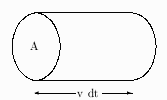Solution to First Assignment: due Friday, January 28, 10 am.
- Text, problem 2.4 a, b: (Wording of problem given only on this first assignment, for those who do not yet have the text)
The origin of the quadratic drag force on any projectile in a fluid is the inertia of the fluid that the projectile sweeps up.
(a) Assuming the projectile has area A (normal to its velocity) and speed v, and that the density of the fluid is r, show that the rate at shich the projectile encounters fluid (mass/time) is rAv.
(b) Making the simplifying assumption that all of this fluid is accelerated to the speed v of the projectile, show that the net drage force on the projectile is rAv².
 (a) In a time dt the area A sweeps out a volume A×(v dt), of mass dm = rAv dt, hence dm/dt = rAv.
(a) In a time dt the area A sweeps out a volume A×(v dt), of mass dm = rAv dt, hence dm/dt = rAv.
(b) This mass starts at rest and gains speed v, hence acquires a momentum
dp = dm · v = (rAv dt)· v in time dt. (It is best not to commit oneself whether this is due to the change in mass or the change in velocity -- the momentum is what really counts in Newton's law)
Therefore the force is F = dp/dt = rAv².
- Text, problem 2.21:
A gun can fire shells in any direction with the same speed v0. Ignoring air resistance and using cylindrical polar coordinates with the gun at the origin and z measured vertically up, show that the gun can hit any object inside the surface
 To visualize what is goig on it helps to draw a diagram of several trajectories. (The dotted curve is the desired limit)
Then there are several ways of doing this, for example one can verify that no point on a trajectory is outside the given surface:
for a trajectory we know r = (v0 cos q) t and
Z = (v0 sin q) t - ½ gt² (where Z refers to a trajectory, to distinguish it from the z of the limiting surface). Eliminating t gives
To visualize what is goig on it helps to draw a diagram of several trajectories. (The dotted curve is the desired limit)
Then there are several ways of doing this, for example one can verify that no point on a trajectory is outside the given surface:
for a trajectory we know r = (v0 cos q) t and
Z = (v0 sin q) t - ½ gt² (where Z refers to a trajectory, to distinguish it from the z of the limiting surface). Eliminating t gives
| Z = (tan q) r - |
g r²
2v0² cos²q |
(*) |
Calculate Z - z = a - u + u²/awhere a = v0²/2g and u = r tan q.
Now the problem amounts to showing Z - z > 0. This is done by minimizing with respect to u, and showing that Z - z = 0 at the minimum.
Another way to find the limiting curve is to note that for any fixed r, the limiting surface occurs at the highest z that is reached for any angle q.
Therefore, differentiate (*) with respect to q, treating r as constant, and set result to 0:
| 0 = |
r
cos²q |
- |
g r²
2 v² | |
2 sinq
cos³q |
Thus r = (v²/g) cot q -- this is where the trajectory starting at q touches the limiting surface. Of course Eq (*) is also valid there.
Eliminating q between these equations gives the cited equation for the surface.
 (a) In a time dt the area A sweeps out a volume A×(v dt), of mass dm = rAv dt, hence dm/dt = rAv.
(a) In a time dt the area A sweeps out a volume A×(v dt), of mass dm = rAv dt, hence dm/dt = rAv.
 To visualize what is goig on it helps to draw a diagram of several trajectories. (The dotted curve is the desired limit)
Then there are several ways of doing this, for example one can verify that no point on a trajectory is outside the given surface:
for a trajectory we know r = (v0 cos q) t and
Z = (v0 sin q) t - ½ gt² (where Z refers to a trajectory, to distinguish it from the z of the limiting surface). Eliminating t gives
To visualize what is goig on it helps to draw a diagram of several trajectories. (The dotted curve is the desired limit)
Then there are several ways of doing this, for example one can verify that no point on a trajectory is outside the given surface:
for a trajectory we know r = (v0 cos q) t and
Z = (v0 sin q) t - ½ gt² (where Z refers to a trajectory, to distinguish it from the z of the limiting surface). Eliminating t gives